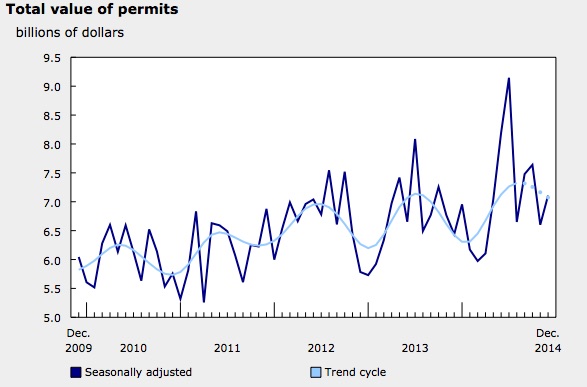
Articles
Business Intelligence
Building permits in Canada up 5.2 per cent in 2014
February 6, 2015 By Stats Canada
Feb. 6, 2015 – Contractors took out building permits worth $7.1 billion in December, up 7.7% from November. This followed a 13.6% decline the previous month. The increase in December resulted mostly from higher construction intentions in the non-residential sector in Alberta and British Columbia.
 Feb. 6, 2015 – Contractors took out building permits worth $7.1 billion in December, up 7.7% from November. This followed a 13.6% decline the previous month. The increase in December resulted mostly from higher construction intentions in the non-residential sector in Alberta and British Columbia.
Feb. 6, 2015 – Contractors took out building permits worth $7.1 billion in December, up 7.7% from November. This followed a 13.6% decline the previous month. The increase in December resulted mostly from higher construction intentions in the non-residential sector in Alberta and British Columbia.
The total value of building permits for 2014 was up 5.2% from 2013 to $85.1 billion.
The value of non-residential building permits rose 22.9% to $2.7 billion in December, following a 29.4% decrease in November. Alberta was responsible for most of the monthly increase at the national level, followed by British Columbia. Declines were recorded in five provinces, with Saskatchewan posting the largest decrease.
Between January and December 2014, municipalities issued non-residential building permits worth $34.2 billion, an increase of 5.4% from 2013.
In the residential sector, the value of permits was unchanged at $4.4 billion in December, following a 2.5% decrease in November. Gains were posted in seven provinces, led by Alberta, British Columbia and Quebec. Ontario posted the largest decrease, following a 16.9% gain the previous month. Saskatchewan and Manitoba also registered declines.
Overall for the year, the value of residential building permits totalled $50.9 billion, up 5.1% from the total value in 2013.
Residential sector: Higher construction intentions for single-family dwellings
Municipalities issued building permits for single-family dwellings worth $2.6 billion in December, up 8.0% from November. Increases were reported in every province, led by British Columbia, Ontario and Alberta.
Construction intentions for multi-family dwellings fell 9.5% to $1.8 billion in December, marking a second consecutive monthly decrease. The decline in December was mainly the result of lower construction intentions in Ontario, followed by Saskatchewan and British Columbia. Gains were registered in five provinces, led by Alberta, followed by New Brunswick and Quebec.
At the national level, municipalities approved the construction of 16,023 new dwellings in December, down 5.6% from November. The decrease came from multi-family dwellings, down 11.9% to 9,550 units. The number of single-family dwellings rose 5.5% to 6,473 units.
Provinces: Large gains in Alberta and British Columbia
The total value of permits was up in seven provinces in December, led by Alberta, followed by British Columbia.
Alberta reported the largest increase, as the value of permits rose 30.7% to $1.7 billion, with higher construction intentions for all types of buildings, most notably for institutional buildings.
British Columbia reported a 20.1% increase to $989 million, the result of higher construction intentions in every component except multi-family dwellings.
The largest decline occurred in Ontario, with institutional buildings and multi-family dwellings accounting for the decrease. Saskatchewan and Manitoba also registered declines.
Higher construction intentions in just over half of the census metropolitan areas
In December, the total value of building permits was up in 18 of the 34 census metropolitan areas.
Edmonton registered the largest gain, followed by Toronto and Vancouver. In Edmonton, higher construction intentions, mainly for institutional buildings and multi-family dwellings, were responsible for the increase. In Toronto, the advance was largely the result of higher construction intentions for industrial buildings, while in Vancouver, the increase came mainly from higher construction intentions for commercial buildings.
Barrie recorded the largest decrease in December, after posting a notable gain the previous month. The decline was the result of lower construction intentions in all components of the residential and non-residential sectors, particularly in multi-family dwellings. Ottawa and Greater Sudbury also registered decreases. In Ottawa, the decline was largely attributable to lower construction intentions for institutional buildings. In Greater Sudbury, institutional and industrial buildings were responsible for the decline.
Print this page
Leave a Reply